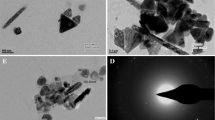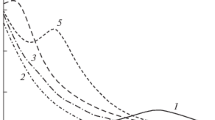Abstract
Cu nanoparticles of well-defined size and stability were synthesized with the aid of a double-template method. The templates consisted of sodium dodecyl sulfate (SDS) aggregates combined with and wrapped by poly(vinylpyrrolidone) (PVP) chains. Copper sulfate was reduced within the templates resulting in multicrystalline Cu nanoparticles. The size of the particles was uniform. They were capped by PVP–SDS complexes and the shape turned out to be non-spherical. PVP used in the experiments has an average molecular weight of 40,000. In this case, the particle dimensions were essentially determined by the chosen concentration of SDS in the reaction solution. No oxidation of the as-grown copper particles was detected even in the absence of inert gas protection during the synthesis process. When exposed to air at room temperature, Cu nanoparticles capped by PVP–SDS complexes showed much better resistance to oxidation than those without the cap** agents. Furthermore, the steric and screening effect of the cap** agents permitted the preparation of uniform colloidal dispersions stable over months. The material obtained by this double-template method was found to be very sensitive to the synthesis temperature. At synthesis temperatures above 40 °C, CuO instead of Cu was obtained.






Similar content being viewed by others
References
Schmitt J, Decher G, Dressick WJ et al (1997) Metal nanoparticle/polymer superlattice films: fabrication and control of layer structure. Adv Mater 9:61–65. doi:10.1002/adma.19970090114
Iwamoto M, Kuroda K, Zaporojtchenko V et al (2003) Production of gold nanoparticles–polymer composite by quite simple method. Eur Phys J D At Mol Opt Phys 24:365–367. doi:10.1140/epjd/e2003-00166-9
Roqué J, Pradell T, Molera J, Vendrell-Saz M (2005) Evidence of nucleation and growth of metal Cu and Ag nanoparticles in lustre: AFM surface characterization. J Non-Cryst Solids 351:568–575. doi:10.1016/j.jnoncrysol.2005.01.043
Wei Y, Chen S, Kowalczyk B et al (2010) Synthesis of stable, low-dispersity copper nanoparticles and nanorods and their antifungal and catalytic properties. J Phys Chem C 114:15612–15616. doi:10.1021/jp1055683
Ahrenkiel SP, Mićić OI, Miedaner A et al (2003) Synthesis and characterization of colloidal InP quantum rods. Nano Lett 3:833–837. doi:10.1021/nl034152e
Xue C, Métraux GS, Millstone JE, Mirkin CA (2008) Mechanistic study of photomediated triangular silver nanoprism growth. J Am Chem Soc 130:8337–8344. doi:10.1021/ja8005258
Sun Y, **a Y (2002) Shape-controlled synthesis of gold and silver nanoparticles. Science 298:2176–2179. doi:10.1126/science.1077229, New York, NY
Zitoun D, Pinna N, Frolet N, Belin C (2005) Single crystal manganese oxide multipods by oriented attachment. J Am Chem Soc 127:15034–15035. doi:10.1021/ja0555926
Mott D, Galkowski J, Wang L et al (2007) Synthesis of size-controlled and shaped copper nanoparticles. Langmuir ACS J Surf Colloids 23:5740–5745. doi:10.1021/la0635092
Jianfeng Y, Guisheng Z, Anming H, Zhou YN (2011) Preparation of PVP coated Cu NPs and the application for low-temperature bonding. J Mater Chem 21:15981. doi:10.1039/c1jm12108a
Jeong S, Song HC, Lee WW et al (2011) Stable aqueous based Cu nanoparticle ink for printing well-defined highly conductive features on a plastic substrate. Langmuir ACS J Surf Colloids. doi:10.1021/la104136w
Park BK, Jeong S, Kim D et al (2007) Synthesis and size control of monodisperse copper nanoparticles by polyol method. J Colloid Interface Sci 311:417–424. doi:10.1016/j.jcis.2007.03.039
Tang X-F, Yang Z-G, Wang W-J (2010) A simple way of preparing high-concentration and high-purity nano copper colloid for conductive ink in inkjet printing technology. Colloids Surf A Physicochem Eng Asp 360:99–104. doi:10.1016/j.colsurfa.2010.02.011
Yelon A, Piyakis KN, Sacher E (2004) Surface plasmons in Drude metals. Surf Sci 569:47–55. doi:10.1016/j.susc.2004.07.028
Ponce AA, Klabunde KJ (2005) Chemical and catalytic activity of copper nanoparticles prepared via metal vapor synthesis. J Mol Catal A Chem 225:1–6. doi:10.1016/j.molcata.2004.08.019
Oh MK, Baik HJ, Kim SK, Park S (2011) Multiple surface plasmon resonances in silver and copper nanorods. J Mater Chem 21:19069. doi:10.1039/c1jm13613e
Kim JH, Ehrman SH, Germer TA (2004) Influence of particle oxide coating on light scattering by submicron metal particles on silicon wafers. Appl Phys Lett 84:1278. doi:10.1063/1.1650555
Lisiecki I, Bjoerling M, Motte L et al (1995) Synthesis of copper nanosize particles in anionic reverse micelles: effect of the addition of a cationic surfactant on the size of the crystallites. Langmuir 11:2385–2392. doi:10.1021/la00007a012
Rice KP, Walker EJ, Stoykovich MP, Saunders AE (2011) Solvent-dependent surface plasmon response and oxidation of copper nanocrystals. J Phys Chem C 115:1793–1799. doi:10.1021/jp110483z
Kanninen P, Johans C, Merta J, Kontturi K (2008) Influence of ligand structure on the stability and oxidation of copper nanoparticles. J Colloid Interface Sci 318:88–95. doi:10.1016/j.jcis.2007.09.069
Yanase A, Komiyama H (1991) In situ observation of oxidation and reduction of small supported copper particles using optical absorption and X-ray diffraction. Surf Sci 248:11–19. doi:10.1016/0039-6028(91)90056-X
Chen C-H, Yamaguchi T, Sugawara K, Koga K (2005) Role of stress in the self-limiting oxidation of copper nanoparticles. The J Phys Chem B 109:20669–20672. doi:10.1021/jp0546498
Tsuji M, Hikino S, Tanabe R et al (2010) Syntheses of Ag/Cu alloy and Ag/Cu alloy core Cu shell nanoparticles using a polyol method. CrystEngComm 12:3900. doi:10.1039/c0ce00064g
Hu J, Fang Y, Wang T et al (2009) A facile one-pot synthesis of hollow Cu2O submicrospheres in virtue of template function of the SDS–PVP necklace-like. Acta Chim Sin 64:1591–1596
Moulder JF, Stickle WF, Sobol PE, Bomben KD (1992) Handbook of X-ray photoelectron spectroscopy: a reference book of standard spectra for identification and interpretation of XPS data, 2nd ed. Edited by Chastain J. Perkin‐Elmer Corp., Physical Electronics Division, Eden Prairie, Minnesota, p. 261
Dutta A, Dolui SK (2008) Preparation of colloidal dispersion of CuS nanoparticles stabilized by SDS. Mater Chem Phys 112:448–452. doi:10.1016/j.matchemphys.2008.05.072
Ghodselahi T, Vesaghi MA (2011) Localized surface plasmon resonance of Cu@Cu2O core–shell nanoparticles: absorption, scattering and luminescence. Phys B Condens Matter 406:2678–2683. doi:10.1016/j.physb.2011.03.082
Linic S, Christopher P, Ingram DB (2011) Plasmonic-metal nanostructures for efficient conversion of solar to chemical energy. Nat Mater 10:911–921. doi:10.1038/nmat3151
Pedersen DB, Wang S (2007) Surface plasmon resonance spectra of 2.8 ± 0.5 nm diameter copper nanoparticles in both near and far fields. J Phys Chem C 111:17493–17499. doi:10.1021/jp075076x
Prasad M, Palepu R, Moulik SP (2006) Interaction between sodium dodecyl sulfate (SDS) and polyvinylpyrrolidone (PVP) investigated with forward and reverse component addition protocols employing tensiometric, conductometric, microcalorimetric, electrokinetic, and DLS techniques. Colloid Polym Sci 284:871–878. doi:10.1007/s00396-005-1453-8
Nagarajan R (1985) Thermodynamics of nonionic polymer–micelle association. Colloids Surf 13:1–17. doi:10.1016/0166-6622(85)80002-0
Chari K, Hossain TZ (1991) Adsorption at the air/water interface from an aqueous solution of poly(vinylpyrrolidone) and sodium dodecyl sulfate. J Phys Chem 95:3302–3305. doi:10.1021/j100161a062
Chari K, Lenhart WC (1990) Effect of polyvinylpyrrolidone on the self-assembly of model hydrocarbon amphiphiles. J Colloid Interface Sci 137:204–216. doi:10.1016/0021-9797(90)90057-U
Griffiths PC, Hirst N, Paul A et al (2004) Effect of ethanol on the interaction between poly(vinylpyrrolidone) and sodium dodecyl sulfate. Langmuir ACS J Surf Colloids 20:6904–6913. doi:10.1021/la049348o
Wang G, Olofsson G (1998) Titration calorimetric study of the interaction between ionic surfactants and uncharged polymers in aqueous solution. J Phys Chem B 102:9276–9283. doi:10.1021/jp9823446
Dhara D, Shah DO (2001) Stability of sodium dodecyl sulfate micelles in the presence of a range of water-soluble polymers: a pressure-jump study. J Phys Chem B 105:7133–7138. doi:10.1021/jp003072l
Wang G, Olofsson G (1995) Ethyl hydroxyethyl cellulose and ionic surfactants in dilute solution. Calorimetric and viscosity study of the interaction with sodium dodecyl sulfate and some cationic surfactants. J Phys Chem 99:5588–5596. doi:10.1021/j100015a049
Acknowledgments
This work was supported by the State Key Lab of Advanced Welding & Joining, Harbin Institute of Technology (AWPT-Z12-02), the Scientific Research Foundation of Harbin Institute of Technology at Weihai (HIT (WH) Y201102), and the Natural Scientific Research Innovation Foundation in Harbin Institute of Technology (HIT.NSRIF.2011118). The authors would like to extend sincere thanks to Prof. Rainer Kimmich of Ulm University, Germany for useful discussions and suggestions.
Author information
Authors and Affiliations
Corresponding author
Electronic supplementary material
Below is the link to the electronic supplementary material.
ESM 1
(PDF 66 kb)
Rights and permissions
About this article
Cite this article
Li, Y., Tang, X., Zhang, Y. et al. Cu nanoparticles of low polydispersity synthesized by a double-template method and their stability. Colloid Polym Sci 292, 715–722 (2014). https://doi.org/10.1007/s00396-013-3123-6
Received:
Revised:
Accepted:
Published:
Issue Date:
DOI: https://doi.org/10.1007/s00396-013-3123-6




